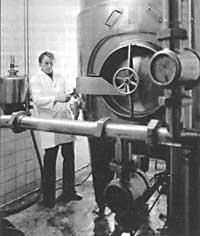Arthur Harden
This famous English biochemist died more than fifty years ago (June 17, 1940), so we consider it a good occasion to give some brushstrokes about his life and work in this brief work.
Arthur Harden was born in Manchester on October 12, 1865 and studied at Owens University in the same city. From there he travelled to Germany to continue his studies and obtained his doctorate at the university of Erlangen in 1888. He then spent ten years at the University of Owens in teaching and writing textbooks.
A discovery by Eduard Buchner changed the life of Harden. Buchner discovered that alcoholic fermentations could be done without living cells and that this idea had fascinated Hard.

In 1897 he joined the Jenner Institute of Preventive Medicine, investigating alcoholic fermentation. In 1904 he put the yeast extract into a bag of semi-permeable membranes and all in clean water. The small molecules of the extract passed through the membrane to the other side, but not by the large molecules. This process is known as dialysis and was invented by the Scottish chemist Thomas Graham in the XIX century. In the mid-twentieth century.
Harden saw that after dialysis the yeast enzymes did not work and the sugar was not fermented. But if, when dialysis was done, the water that was inside the pouch was thrown out, the fermentation was advancing again. It seemed that the enzyme had two parts: one formed by small molecules and the other formed by large molecules.
If the internal substance of the pouch was boiling, the fermentation process was paralyzed, although the external liquid was added. Large molecules appeared to be proteins and not small molecules that survived with boiling water. This trial first demonstrated that a protein-like enzyme needs a small coenzyme or molecule other than the protein to function.
Swedish chemist Euler-Chelpin investigated these coenzymes and Dutchman Christiaan Eijkman showed that the vitamins found were necessary to live. Since few enzymes working as catalysts are needed, the amount of coenzyme and vitamin needed would also be very small.
In his essays Arthur Harden discovered another interesting thing. Yeast extraction breaks down glucose and produces carbon oxide at first quickly, but as the fermentation progresses, the activity decreases. Therefore, the enzyme is weakened over time.
In 1905, however, Harden showed that the activity could be kept rapidly adding inorganic phosphate to the dissolution. Thus, the enzyme was maintained at the initial level. But no phosphorus was produced that presented alcohol, nor carbon dioxide, nor the enzyme. As phosphate disappeared, Harden began to look for organic phosphate and found it in sugar. The sugar molecule was joined by two groups of phosphates during fermentation and after many other reactions, the phosphate groups were released again. It was the beginning of internal metabolism, which is now the most important branch of biochemistry.
Harden demonstrated with his work the importance of phosphates in all parts of biochemistry. Then, Core's marriages turned around this topic when they described in detail all phases of fermentation.
Harden won in 1929 the Nobel Prize in Chemistry together with Euler-Chelpin for his fermentation work.
However, Harden previously taught biochemistry at the University of London in 1912. Before (1911) he published a book: “Alcoholic fermentation”. He also participated in the journal “The Biochemical Journal” between 1913 and 1937.
By his merits he was appointed “Sir” in 1936 and four years later, in 1940, he died on 17 June. Fifty years ago.
Buletina
Bidali zure helbide elektronikoa eta jaso asteroko buletina zure sarrera-ontzian











